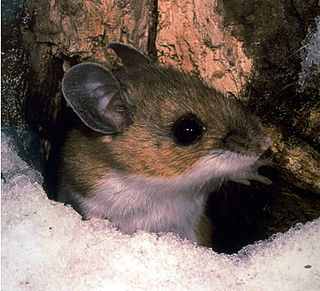
The Neotominae are a subfamily of the family Cricetidae. They consist of four tribes, 16 genera, and many species of New World rats and mice, predominantly found in North America. Among them are the well-known deer mice, white-footed mice, packrats, and grasshopper mice.

The Mexican woodrat is a medium-sized pack rat.
The Tamaulipan woodrat is a species of rodent in the family Cricetidae. It is found only in Mexico. It is endemic to the Sierra Madre Oriental in the Mexican states of Tamaulipas and San Luis Potosí.
Anthony's woodrat is an extinct subspecies of Bryant's woodrat in the family Cricetidae. It was found only on Isla Todos Santos in Baja California, Mexico. It is thought to have been driven to extinction through predation from feral cats.
Bryant's woodrat is a species of new-world rodent in the family Cricetidae native to the Southwestern United States and Mexico. It is named after Walter E. Bryant, who collected the holotype of this species in 1885.
Bunker's woodrat is an extinct subspecies of Bryant's woodrat in the family Cricetidae. Only five specimens are known; these were collected in 1932 by W.H. Burt and are housed at a museum at UCLA. Neotoma bunkeri was only described from Coronados Islands, Baja California, Mexico. It probably died out as a result of depletion of food resources and predation by feral cats.

The bushy-tailed woodrat, or packrat is a species of rodent in the family Cricetidae found in Canada and the United States. Its natural habitats are boreal forests, temperate forests, dry savanna, temperate shrubland, and temperate grassland.
The Arizona woodrat is a species of rodent in the family Cricetidae. It is found in Mexico and the United States.

The dusky-footed woodrat is a species of nocturnal rodent in the family Cricetidae. Nicknames include "packrats" or "trade rats" because of their tendency to hoard things, build large domed dens, and "trade" by dropping then picking up another object for it. Coyotes and other predators will attempt to prey on these rodents by laying waste to the dens, but the sheer volume of material is usually dissuasive. Occasionally, dusky-footed woodrats will build satellite dens in trees. Although these animals are solitary, except in the mating season, dens are frequently found in clusters of up to several dozen, forming rough "communities". The mating system in this species appears to be variable, with promiscuity most generally at high population densities and monogamy at lower densities.

Goldman's woodrat is a rodent species in the family Cricetidae. It is found only in Mexico throughout the Mexican Plateau, stretching from southeastern Chihuahua to southern San Luis Potosí and northern Querétaro. The plateau is an average 5,988 ft. above sea level and covers a land area of 232,388 sq. miles.
The San Martín Island woodrat is an extinct subspecies of Bryant's woodrat in the family Cricetidae.

The Southern Plains woodrat is a species of rodent in the family Cricetidae. It is found in northwest Mexico and in Colorado, Kansas, New Mexico, Oklahoma, and Texas in the United States. The subspecies Neotoma micropus leucophaea: White Sands woodrat, is white in coloration and found only at White Sands National Park in New Mexico.
Nelson's woodrat is a species of rodent in the family Cricetidae. It is endemic to Mexico, where it is known only from the eastern slopes of the volcanoes Orizaba and Cofre de Perote. Due to the small geographic range, isolation, and low population, the Nelson's woodrat has a higher risk for extinction. The distribution and population sizes are small. The population exists in geographic isolation, which prevents gene flow
The Bolaños woodrat is a species of rodent in the family Cricetidae found only in Mexico.

The Sonoran woodrat is a species of rodent in the family Cricetidae found only in Mexico.
Stephen's woodrat is a species of rodent in the family Cricetidae found in Arizona, New Mexico and Utah in the United States.

Neotoma leucodon is a species of rodent in the family Cricetidae. Although originally named from San Luis Potosí, Mexico, as a species by Clinton Hart Merriam, the white-toothed woodrat was long considered to be a synonym of the white-throated woodrat. Molecular data, however, indicate the populations east of the Rio Grande in New Mexico and Trans-Pecos Texas represent a different species than morphologically similar populations west of the river.

The big-eared woodrat is a nocturnal rodent of the woodrat genus Neotoma, in the family Cricetidae. Closely related to, and formerly included in the species Neotoma fuscipes, it is endemic to western North America and occurs west and south of the Salinas Valley from the California Coast Ranges south of Monterey Bay to northern Baja California, as well as in the Sierra Nevada, extending north to the South Fork American River.

The Sarawak surili, Bornean banded langur, or cross-marked langur is a species of primate in the family Cercopithecidae. It is endemic to the southeast Asian island of Borneo, where it is distributed north of the Kapuas River in Kalimantan, Indonesia, the Malaysia states of Sarawak and Sabah, and in Brunei. Its taxonomy is complex and disputed, and it has been considered a subspecies of P. femoralis or P. melalophos. The Sarawak surili was formerly considered common, but has declined drastically due to persecution and habitat loss, and as of 2015 is only known from five sites with a combined population of 200–500 individuals. Consequently, it is believed to be one of the rarest primates in the world, and has been rated as critically endangered by IUCN.

A pack rat or packrat, also called a woodrat or trade rat, are any species in the North and Central American rodent genus Neotoma. Pack rats have a rat-like appearance, with long tails, large ears, and large, black eyes. Pack rats are noticeably larger than deer mice, harvest mice, and grasshopper mice, and are usually somewhat larger than cotton rats.










